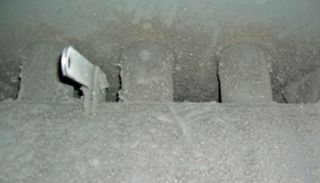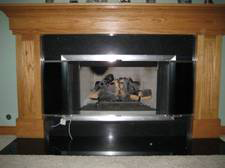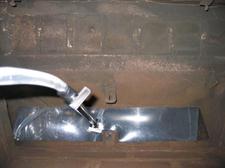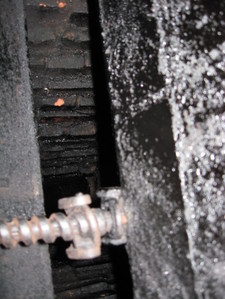
by blogediter | Jun 1, 2019 | Chimney Plugs
HEK Chimney Balloon
Q: Hi, I stumbled across your site today, and I am very interested in one of your Chimney Balloons. I have a question. My chimney has a system to take cold air off the floor in front of the hearth, and draw it through some pipes that run through the flue. This warm air is then fan forced out above the fireplace. The question is whether your Chimney Balloon will go between these pipes and the damper, or squeeze through between the pipes, and be inflated above them. I can take a digital picture and send or maybe take some measurements and send those… – CF
A: CF, Most people refer to those systems as heatilators (but that is a brand name.) A deflated Chimney Balloon needs a gap of 2″ to 2.5″ to fit through. Once you are through these pipes you should be good to go. I would suggest using a folding carpenters ruler to measure the pipes so you can tell how large a Chimney Balloon you need. You may need to consider an extension for your Chimney Balloon if you plan on reaching very far past the heatilator pipes to inflate the Chimney Balloon. The Handle/valve Extender kit (HEK) will give you an extra 16″ of reach to add to your 12″ Chimney Balloon handle.
by blogediter | May 29, 2019 | Chimney Plugs
Where to Measure a Heatelator Pre-Fab Fireplace
Jason, I have a fireplace in our basement that I want to plug since we do not use it.
There is a metal damper that operated on a hand crank just 3″ above the fireplace opening. However, about 14″ above the damper is an 11″x11″ terra cotta flue tile that I think I can easily get a Chimney Balloon into. The website instructions say to buy a Chimney Balloon that is a little large…should I get a 15×15 or 12×12 Chimney Balloon and should I buy a HEK extender with it? – RW
Dear RW, You sized up this application well and your instinct is right-on to go with a 12×12 with a HEK Extender.
11″x11″ is a very common size flue tile, and experience tells me that a 12×12 Chimney Balloon is the perfect size to plug that flue. Since your flue tile terminates just 14″ above the damper then you can certainly use a HEK extender to get it up there and installed. I have attached some pictures that are similar to your install. – Jason

by blogediter | May 8, 2019 | Fireplaces
Q: Jason, I have a Majestic SR42A 42″ prefab wood-burning fireplace with gas logs. The damper is 8″ round and opens/swivels in the middle of the circle. The firebox is a trapezoid with approximate dimensions of 24 X 33 with the sides being 15″.
There is a front “panel” that seems to be angled inward making the 15″ sides taller at the top and smaller at the bottom. There seems to be sufficient room between the damper and the top of the fireplace opening (9″) for a larger Chimney balloon. The front panel may also make a good “shelf” for the Chimney Balloon to rest on.
I’m wondering if the best bet is to go with a smaller Chimney Balloon and install it above the damper with the extender or get a bigger Chimney Balloon and install it under the damper, in the trapezoid firebox area. My preference would be for easy installation and removal as we use our fireplace a lot in the winter. I don’t mind if part of the Chimney Balloon or pole shows. – CA
A: Dear CA, You have a couple of choices in how to install your
Chimney Balloon.
Option 1: If you plan on putting in the
Chimney Balloon and leaving it (ie. not using this fireplace much) than I would suggest you get a 9×9 and put it above the damper with an HEK extender. This configuration will get your
Chimney Balloon up and out of sight from the
firebox area and it will give you a nice tight seal in the
flue area.
Option 2: If you will use this gas log fireplace regularly and you are looking for the easiest place to install a
Chimney Balloon to take it in and out. I would recommend you get a 36×15
Chimney Balloon and install it right in the firebox below the damper. When your damper is closed the handle will be up and out of the way and you have a nice trapezoidal spot there that is 9″ tall to put the
Chimney Balloon in. The only downside is that you may be able to see the
Chimney Balloon a little bit in the
firebox. Also, you will want to be careful of the sharp edges on the damper handle bracket that I see in this picture that holds the damper up when it is closed. Those brackets can have a sharp edge on the tip of them so you may want to put a piece of tape over that spot so you can get maximum longevity out of your
Chimney Balloon. Sharp spots like that can tend to wear out the
Chimney Balloon early if you are installing and uninstalling regularly. – Jason

by blogediter | Apr 15, 2019 | Save Energy
Q: Jason, the cable that leads up to my Lymance chimney top damper seems to be puncturing my Chimney Balloon. I attached an image of the damper to show you where the cable is. -TP
A: TP- I see the cable as a very faint line just to the left of the Chimney Balloon valve in the picture. I see the cable runs along the edge of your metal damper there as well. What is happening is this cable is getting frayed over time as it rubs up and down against the metal edge of this damper opening. That frayed section of cable has little needle like protrusions and a flat side that is like a saw blade in roughness. I also notice that the Chimney Balloon is tight like a drum when installed. It is probably a little two tightly inflated.
Two things will help solve your issue here…
- Remove your Chimney Balloon and wrap packaging tape around your chimney top damper cable in the area the Chimney Balloon will come in contact with it. This will keep the flat sharp end of this cable from cutting the balloon.
- When you reinstall and inflate your Chimney Balloon do not fill it so tightly full with air. You can leave a little give in it. – Jason

by blogediter | Apr 5, 2019 | Chimney Plugs
Q: Jason, On the “Sizing a Chimney Balloon” portion of the Chimney Balloon fireplace damper website it says to find a spot in the chimney that is low, like in the smoke shelf of the smoke chamber or by the damper, to measure for and install your Chimney Balloon? Why shouldn’t I just measure higher-up in the flue and install a Chimney Balloon up there? A smaller Chimney Balloon costs less money. – JC
A: JC, I know it is tempting for you to think we recommend a lower install location because we are just trying to sell a larger more expensive Chimney Balloon. But that is not why we suggest this. There are a number of reasons why you should install a Chimney Balloon in a lower location. Here are a few:
- It is best to install a Chimney Balloon in an area that you can reach with your hand because it will be easier to install and uninstall. When installing the Chimney Balloon you may need to prod a corner into place or adjust the alignment of the Chimney Balloon with your hand, and this is easier to do if the Chimney Balloon is installed in an easy to reach location. We make handle valve extenders for the Chimney Balloon in case it is not possible to install in an easy to reach location.
- If you do have a smoke shelf or smoke chamber then this structure shelf will help to support the weight of the Chimney Balloon once installed. The Chimney Balloon is designed to hold itself in place just by grabbing the flue sides through air pressure, but a smoke shelf makes its job even easier as it gives the bottom of the Chimney Balloon a location to rest. If the shelf is unusually deep and you need the valve of your Chimney Balloon to be somewhere other than the direct center of the Chimney Balloon this can be done through our custom order process. Here is a link to the blog about how to order a custom Chimney Balloon.
- If you install a Chimney Balloon low down you will be sealing off more of the fireplace inner chimney surface from your home. There are two advantages to this. If the creosote of your fireplace is particularly smelly or humid this isolates your home air from being contaminated by the chimneys smoky creosote smell. The other advantage is that heated air in a fireplace chimney tends to naturally cool and sink and create a draft sensation (Here is an article that addresses problems with top sealing dampers that tend to not stop the chimney draft)
The damper photo image above is a perfect example. The fireplace owner told us the chimney area is humid and sooty and smelly and the damper leaked cold air. We recommended a Chimney Balloon to be installed just above the damper, nice and low. After the customer installed the properly sized Chimney Balloon and used vinegar to neutralize the smokey aroma, the stinky fireplace smell stopped for good. – Jason



